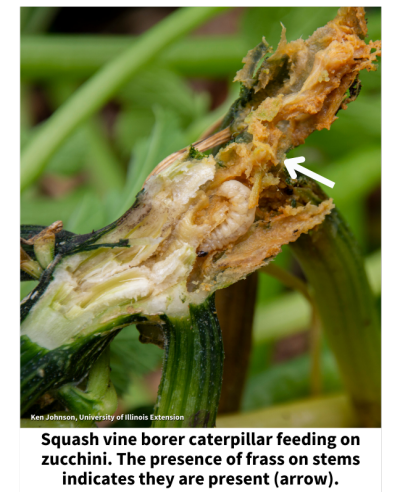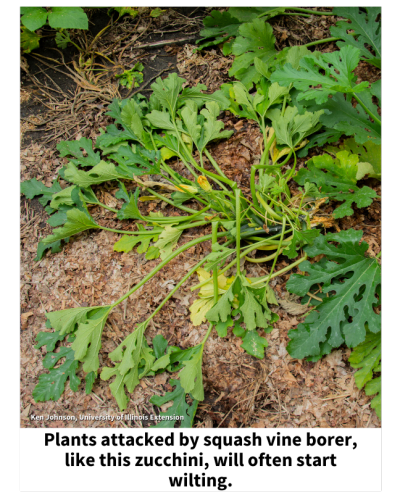|
 Squash vine borers (Melittia cucurbitae) will feed
on both summer and winter squash and pumpkins as caterpillars. The
adult moths are 5/8- to 1-inch long and colorful. Their abdomens are
usually orange with black dots. Their hind legs are orange and black
and hairy. Their front wings are greenish-black, while the hind
wings are colorless with dark veins. Squash vine borers (Melittia cucurbitae) will feed
on both summer and winter squash and pumpkins as caterpillars. The
adult moths are 5/8- to 1-inch long and colorful. Their abdomens are
usually orange with black dots. Their hind legs are orange and black
and hairy. Their front wings are greenish-black, while the hind
wings are colorless with dark veins.
The adults fly during the day, often darting around in a zig-zag
pattern. Because they fly during the day, they are commonly
misidentified as wasps. The adults will emerge from mid-June to
early July and lay eggs, primarily near the base of stems, but they
can be found on other parts of the plant (elsewhere on stems and
petioles).
After the eggs are laid, they will start to hatch in about 10-14
days. The larvae (caterpillars) will bore into the stems and begin
to feed. When they enter the plant, they will leave a small hole,
and as they feed, they will push sawdust-like frass (insect
excrement/poop) out of the hole, which will accumulate over time.
While the larvae are most commonly found near the base of the plant,
they can be found throughout the plant and even in fruit,
particularly later in the season.
As the caterpillars feed, they will tunnel through the stems. This
will often cause wilting of vines, especially during the heat of the
day. As feeding continues, the vines the caterpillars are feeding on
may eventually die. The larvae will grow to be about 1" and have a
whitish body and brown head. After feeding for 4-6 weeks, they will
emerge and burrow into the ground, where they will eventually
pupate. In southern Illinois, there can be two generations.



[to top of second
column] |


Often, by the time gardeners notice their damage,
little if anything can be done. Fortunately, there are steps you can
take to prevent them from attacking your plants and, if caught early
enough, steps you can take to control them:

• Covering plants with floating row covers can help keep squash vine
borers off of plants. If you have had trouble in the past, make sure
you are growing in a different area since they overwinter in the
soil. Covers will need to be removed, or plants will need to be
hand-pollinated once plants begin producing female flowers.
• Altering your planting date or planting a second crop in early
July to avoid peak egg-laying can help reduce the likelihood that
plants will be attacked.
• Some cucurbits are more susceptible to squash vine borer than
others. Summer squash, zucchini, acorn squash, and Hubbard squash
are some of the most susceptible. On the other hand, cultivars of
Cucurbita moschata like butternut squash, calabaza, crookneck
squash, and some pumpkins, along with other cucurbits like cucumbers
and melons, are far less susceptible.
• If you are growing vining cucurbits, bury a few nodes on each
vine. This will cause the plants to root and can lessen the impact
of any squash vine borers that may attack the plant.
• Scout your plants for the presence of larvae. If you notice any
frass, you can cut the vine lengthwise near the entry hole and
remove the larva. Once the larva is removed, cover the stem with
soil.
• If you decide to apply pesticides, apply them to the plants'
crowns and runners when they begin to run. Apply late in the day to
avoid pollinators. Once caterpillars are inside of the plants,
foliar pesticide applications won't have any effect on them.
Good Growing Tip: Good sanitation can help reduce squash vine borer
populations. When you are done with your squash and pumpkins in the
fall, remove the plants and shred or otherwise destroy them. This
will help get rid of any caterpillars that may still be present in
the vines. [SOURCE: Ken
Johnson, Horticulture Educator, University of Illinois Extension] |